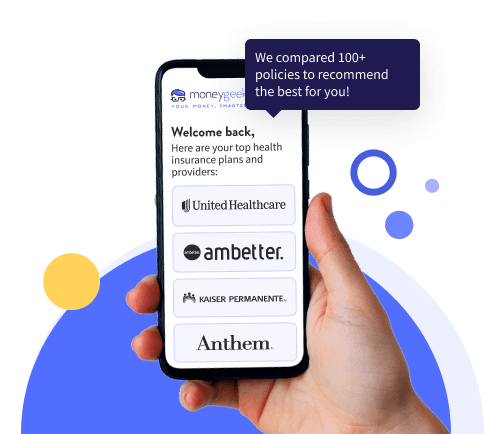Your deductible is the amount you pay for covered services before your insurance starts helping with costs. If your plan has a $2,000 deductible, you'll pay the first $2,000 of covered services yourself. After meeting your deductible, you'll typically pay copays or co-insurance until you reach your out-of-pocket maximum. Preventive care like annual checkups often doesn't require meeting your deductible first.
Deductible vs. Out-of-Pocket Maximum
Your deductible and out-of-pocket maximum work together to cap health care spending. Learn how each affects your costs and when your insurance covers 100%.
Compare deductible amounts and out-of-pocket limits below.

Updated: November 19, 2025
Advertising & Editorial Disclosure
Your deductible is what you pay before insurance starts covering most services, while your out-of-pocket maximum caps total yearly health care spending.
Once you hit your out-of-pocket maximum, your insurer covers 100% of in-network care for the rest of the year.
For 2026, Marketplace plans limit out-of-pocket maximums to $10,600 for individuals and $21,200 for families.
What Is a Deductible?
What Does a Deductible Cover?
Your deductible applies to most covered health care services and prescription drugs before your plan starts paying. Preventive care, like annual checkups and screenings, is typically free, even before you meet your deductible. Here's what counts toward your deductible:
- Visits to your doctor or a specialist
- Lab work and imaging tests (X-rays, MRIs)
- Surgeries and outpatient procedures
- Emergency room care
- Prescription drugs (some plans use a separate deductible for medications)
- Hospital stays
- Therapy for mental health
- Physical therapy and rehab
What Is Out-Of-Pocket Maximum?
Your out-of-pocket maximum (MOOP) caps what you'll spend on covered health care in a year. For 2025, Marketplace insurance plans can't exceed $9,200 for individuals or $18,400 for families. For 2026, these limits increase to $10,600 and $21,200, respectively. Once you reach this limit, your insurance covers 100% of covered services for the remaining year. Your monthly premiums and out-of-network costs don't count toward this maximum.
What Applies to Your Out-of-Pocket Maximum (MOOP)?
Your deductible, copays and co-insurance for in-network covered services count toward your out-of-pocket maximum. Here's what does and doesn't apply:
Counts Toward Your Maximum | Doesn't Count Toward Your Maximum |
|---|---|
Your annual deductible | Monthly premiums |
Copays for doctor visits | Out-of-network care |
Co-insurance payments | Services your plan doesn't cover |
Prescription drug costs (if included) | Costs above your plan's allowed amount |
What Is the Difference Between Deductible and Out-Of-Pocket Maximum?
Your deductible and out-of-pocket maximum work together to limit health care costs but cover different spending phases. Your deductible resets yearly and must be met before most coverage starts. Your out-of-pocket maximum includes your deductible plus additional costs like copays and co-insurance.
What it is | Amount you pay before insurance covers most services | Total limit on your yearly health care spending for covered services |
What counts toward it | Medical services, prescriptions, lab tests (varies by plan) | Deductibles, copays, co-insurance for covered services |
What doesn't count | Premiums, out-of-network care (most plans) | Premiums, out-of-network care, non-covered services |
When coverage starts | After you meet the full deductible amount | You pay nothing after reaching this limit |
2025 marketplace limit | Varies by plan (no federal maximum) | $9,200 individual, $18,400 family |
Reset frequency | January 1 each year | January 1 each year |
How Does Deductible and Out of Pocket Maximum Work?
Think of your deductible and out-of-pocket maximum as two safety nets that protect you from massive medical bills. Your deductible comes first and you'll pay the full cost of covered services until you hit this amount. After that, you split costs with your insurer through co-insurance and copays. Once your total spending reaches the out-of-pocket maximum, your insurer picks up 100% of covered services for the rest of the year. Let’s see how these financial limits together work in practice:
- 1Come January 1st, your deductible starts over.
You'll pay for covered services again from scratch, no matter how much you spent the previous year.
- 2After meeting your deductible, you share costs with your insurer.
You'll typically pay 20% to 30% of costs (co-insurance) or set amounts (copays) for services like doctor visits and prescriptions.
The out-of-pocket maximum stops your costs from spiraling. For 2026, Marketplace plans can't exceed $10,600 for individual coverage or $21,200 for family coverage.
- 3Not everything you spend counts toward these limits
High-deductible health plans have lower caps at $8,500 for individuals and $17,000 for families. Your monthly premiums, out-of-network care and non-covered services won't apply to your deductible or out-of-pocket maximum.
How Can You Save on Your Deductible and Out of Pocket Maximum?
Cutting your health care costs takes a bit of work, but you'll save real money. The trick is picking the right plan and using pre-tax accounts to your advantage. You can't dodge your deductible or out-of-pocket maximum entirely, but you can make them easier to handle.
Try a Health Savings Account if you've got a high-deductible plan. For 2026, all Bronze and Catastrophic plans work with HSAs. You can stash up to $4,400 for individual coverage or $8,750 for family coverage. The money cuts your taxable income, rolls over year to year and grows without Uncle Sam taking a cut. You'll use it to cover your deductible, copays and co-insurance without paying taxes on that money.
Go with a Silver plan if you qualify for cost-sharing reductions. These extra savings drop your deductible, copays and co-insurance — but only Silver plans offer them. Your deductible could fall from $750 to $300 or $500, depending on your income, according to HealthCare.gov. That's hundreds of dollars in savings right there.
Stick with your plan's network. Out-of-network care won't count toward your deductible or out-of-pocket maximum, leaving you stuck with the full bill.
Here's a smart timing trick for big expenses. Once you've hit your deductible, your costs drop significantly. Need multiple procedures in one year? Schedule them after you've met your deductible to get the most value from your plan.
Take advantage of free preventive care. Annual checkups, screenings and vaccinations don't count toward your deductible because they're free under all Marketplace plans. Catching problems early saves you money down the road.
Bottom Line
Your deductible kicks in first. You'll cover costs until you hit that amount, then your insurer helps through co-insurance and copays. Hit your out-of-pocket maximum? You're done paying for the year. Your plan picks up 100% of covered services after that point.
Out Of Pocket Maximum vs. Deductible: FAQ
We've answered frequently asked questions about the difference between deductibles and out-of-pocket maximums to help you understand how these costs work:
Does deductible go towards out of pocket max?
Yes, your deductible counts toward your out-of-pocket maximum. Every dollar you pay for your deductible, plus copays and co-insurance for covered services, brings you closer to your out-of-pocket maximum. Once you hit that limit, your insurer covers 100% of covered services for the rest of the year.
What happens when you meet your out of pocket maximum?
Your insurance covers 100% of covered services once you reach your out-of-pocket maximum. You won't pay copays, co-insurance or deductibles for the rest of the plan year. This protection caps your health care spending at known limits: $10,600 for individuals or $21,200 for families in 2026 Marketplace plans.
Is a high deductible plan right for me?
High-deductible plans work well if you're healthy and rarely need medical care beyond preventive services. You'll pay lower monthly premiums and can use a Health Savings Account to save money tax-free. For 2026, you can contribute up to $4,400 for individual coverage or $8,750 for family coverage.
What happens when I reach my deductible?
After meeting your deductible, you share costs with your insurer through copays and co-insurance. You'll typically pay 20% to 30% of costs for covered services instead of the full amount. These payments continue until you reach your out-of-pocket maximum, when your insurer covers 100% of covered care.
Does your copay and coinsurance go toward your deductible?
No, copays and co-insurance don't count toward your deductible. These costs only apply after you've met your deductible. However, all three: your deductible, copays and co-insurance for in-network covered services, count toward your out-of-pocket maximum. Your monthly premiums and out-of-network costs don't count toward either limit.
Related Articles
About Mark Fitzpatrick

Mark Fitzpatrick, a Licensed Property and Casualty Insurance Producer, is MoneyGeek's resident Personal Finance Expert. With over five years of experience analyzing the insurance market, he conducts original research and creates tailored content for all types of buyers. His insights have been featured in publications like CNBC, NBC News and Mashable.
Fitzpatrick holds a master’s degree in economics and international relations from Johns Hopkins University and a bachelor’s degree from Boston College. He's also a five-time Jeopardy champion!
He writes about economics and insurance, breaking down complex topics so people know what they're buying.

